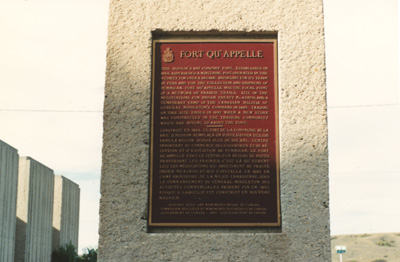Fort Qu'Appelle National Historic Site of Canada
Fort Qu'Appelle, Saskatchewan

Photo of plaque
© Parks Canada Agency / Agence Parcs Canada, n.d.
Address :
198 Bay Avenue North, Fort Qu'Appelle, Saskatchewan
Recognition Statute:
Historic Sites and Monuments Act (R.S.C., 1985, c. H-4)
Designation Date:
1953-05-26
Dates:
-
1864 to 1864
(Construction)
-
1864 to 1897
(Significant)
-
1874 to 1874
(Significant)
-
1885 to 1885
(Significant)
Event, Person, Organization:
-
Indian Treaty no. 4
(Event)
-
General Middleton
(Person)
-
Hudsons Bay Company
(Organization)
Other Name(s):
-
Fort Qu'Appelle
(Designation Name)
Research Report Number:
1968-029, 2011-CED/-SDC-002
Plaque(s)
Existing plaque: 198 Bay Avenue North, Fort Qu'Appelle, Saskatchewan
This Hudson's Bay Company fort, established in 1864, superseded a wintering post operated in the vicinity for over a decade. Important for its trade in furs and for the collection and shipment of pemmican, Fort Qu'Appelle was the focal point of a network of prairie trails, site of the negotiations for Indian Treaty No. 4 (1874), and a temporary camp of the Canadian militia of General Middleton's command in 1885. Trading on this site ended in 1897 when a new store was constructed in the thriving community which had sprung up about the fort.
*Note: This designation has been identified for review. A review can be triggered for one of the following reasons - outdated language or terminology, absence of a significant layer of history, factual errors, controversial beliefs and behaviour, or significant new knowledge.
Description of Historic Place
Fort Qu’Appelle National Historic Site of Canada is situated in the town of Fort Qu’Appelle in southern Saskatchewan. This fort was originally a small trading post surrounded by a log palisade on the open prairie. The site, overlooking the Qu’Appelle River, is now located at the town’s northern perimeter on a grassy lot edged with trees. All that remains from the 19th-century Hudson’s Bay Company trading post is one original building that now houses a museum. A 20th-century addition has allowed for expansion. An HSMBC plaque is also located on the site. Official recognition refers to a polygon bounded by Hudson Avenue, Broadway Street, Company Avenue and 3rd Street in the town of Fort Qu’Appelle, Saskatchewan.
Heritage Value
Fort Qu’Appelle was designated a national historic site of Canada because of: its role as a main fur trade depot for the latter half of the 19th century.
Fort Qu’Appelle, a trading post just south of the Qu’Appelle River in southern Saskatchewan, was established in 1864 by the Hudson’s Bay Company (HBC) at the centre of a network of trails. Although numerous HBC posts had used the name ‘Fort Qu’Appelle’ since the early 1800s, the post established in 1864 was a major provision post for the southern Prairies. The post was forced to close after approximately eight years of operation due to the diminishing bison population. The post would form the basis for the town of Fort Qu’Appelle, Saskatchewan. The fort was also the site of the negotiations for Indian Treaty No. 4 in 1874 and served as a temporary camp of the Canadian Militia of General Middleton’s command during the 1885 Rebellion.
Character-Defining Elements
Key features contributing to the heritage value of this site include: - its strategic location near the Qu’Appelle River’s southern bank in southern Saskatchewan; - the one remaining building of the HBC trading post established in 1864, its original massing, and materials; - the integrity of any surviving archaeological remains, features and artefacts from the fort’s period of occupation in their original placement and extent, including the in situ vestiges of structural remains; - the viewscapes to and from the site and the immediate surroundings that facilitate its recognition as an important trading post.